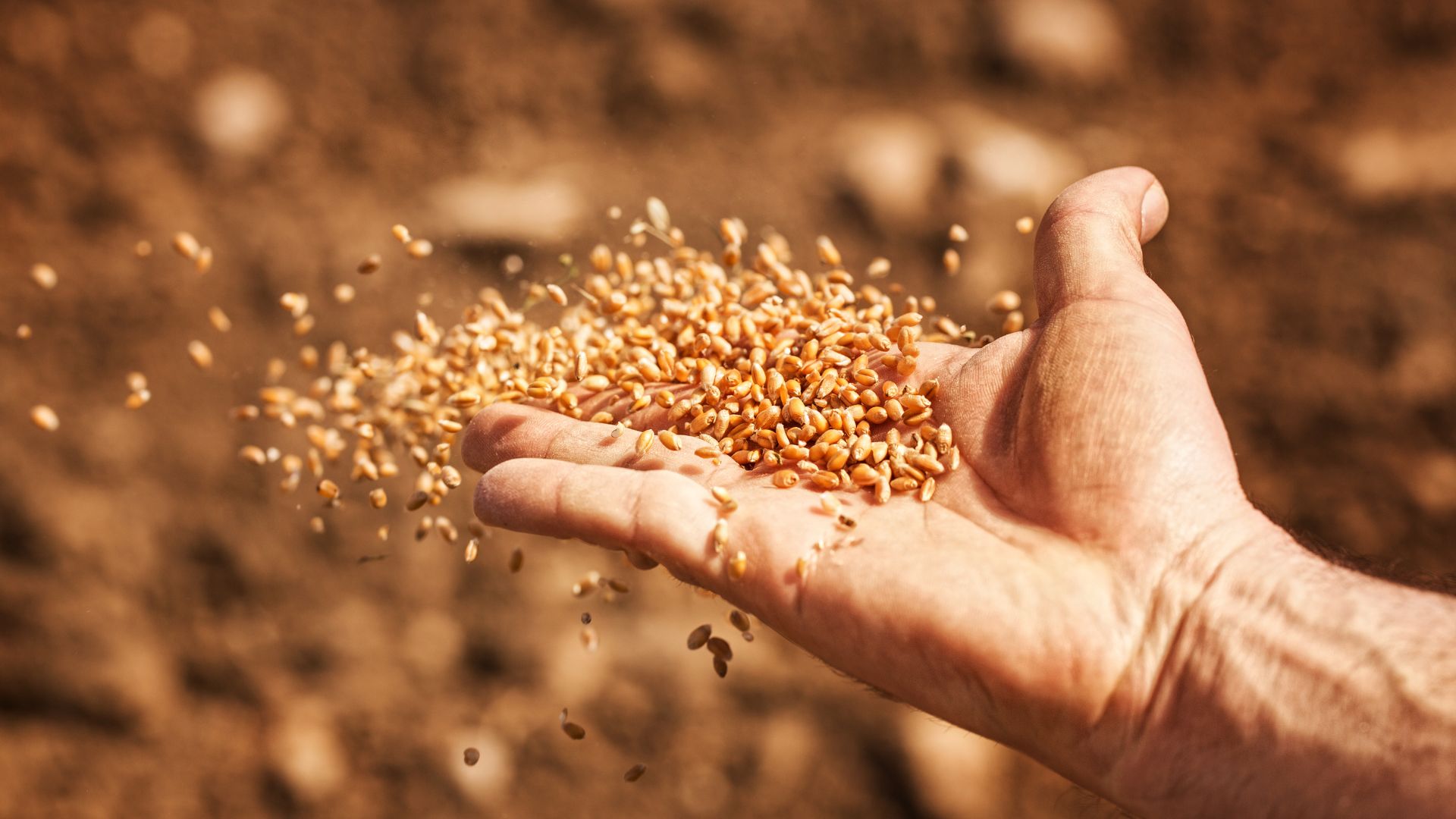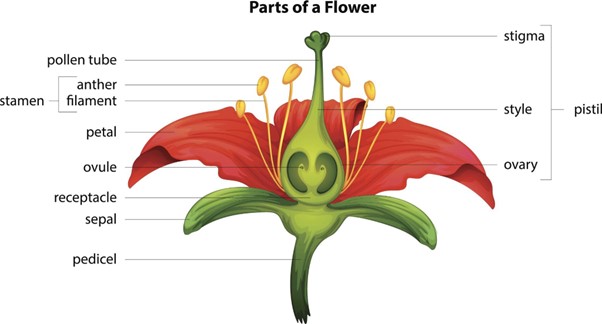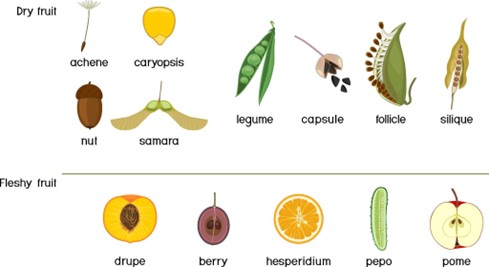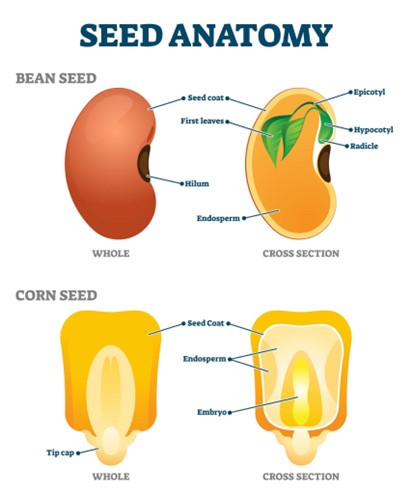Sexual Propagation of a Plant – Everything around seeds

This post is also available in:
This post is also available in:
![]() Deutsch (German)
Deutsch (German) ![]() Ελληνικά (Greek)
Ελληνικά (Greek)
A plant is propagated sexually when it produces seeds. This process involves the reproductive organs of the plant (flowers), the successful transport of the male gametes (pollen grains from the flower’s anthers) to the female flower part (stigma)(pollination), and the fertilization of the female egg cell. If all factors are ideal, a fruit or/and seed(s) will be produced. Except for their importance as reproduction material (both for angiosperms and gymnosperms plant species), seeds of many crop species are used as an essential food source [e.g., grains (e.g., wheat, rice, and maize), legumes, etc.) and are the only propagation material that can be used in breeding programs for creating and improving plant varieties.
Note: In general, when referring to seeds, we mean the botanical seeds produced by the fertilization of a plant’s flower(s) (e.g., wheat and maize grains). However, in agriculture, other plant parts are also used as propagation materials that are named/referred to as seeds (agricultural seeds). Some common examples are the potato tubers and the sugarcane setts. In this article, we will focus only on the “true” botanical seeds that are the result of the sexual reproduction of plants.
Anatomy of a flower
While there might be a large variation regarding the appearance and the structure/anatomy of a flower, most consist of the following parts (as demonstrated in the picture):
● The petals, sepals, and pedicel
● The female part: the pistil (which consists of the stigma, pollen tube, style, and ovary (with the ovule)
● The male part: the stamen (that consists of the anthers (containing the pollen grains→ male gametes) and the filaments).

What are Monoecious and Dioecious Plants?
All plant species belong to one of these 2 categories based on their anatomy in regard to the reproductive organs the plant carries.
● Monoecious: The plants classified in this category have male and female flowers on the same plant or plants with hermaphrodite flowers.
o Hermaphrodite or Selfer: These flowers (or plants) have both the male and female organs in one single flower of a plant.
● Dioecious or Outcrossers: In this category, we classify all plant species with flowers carrying only female or male reproductive organs. These plants need the presence of compatible female and male plants of the species growing at a close distance to one another, flowering simultaneously, and the existence of an efficient pollinator to transfer the pollen from the male plant to the female plant.
Hybrids and Open-Pollinated Varieties (landraces)
Most farmers know that one of the main factors affecting a crop’s performance is the variety chosen for cultivation and the quality of the propagation material used. A variety is a set of individuals that belong to the same species and are closely related to each other, forming a relatively phenotypically uniform population. The uniformity among the population, regarding the germination and growth rate, as well as the maturity time and the traits and quality of the end product, is a key characteristic. Nowadays, the majority of the varieties of the most important crop species propagated by seeds belong to the following categories:
Open-Pollinated varieties
The individuals of such varieties have been created by a free cross-pollination among a group of plants. While in many modern open-pollinated varieties, a good level of uniformity has been accomplished, the population consists of genetically different individuals. These varieties have the advantage of higher adaptability and resilience thanks to the genetic diversity of their individuals. For this reason, open-pollinated varieties are preferred in low-input systems (and agrosystems) and are generally more tolerant to stresses (especially abiotic stresses). Moreover, they permit on-farm seed production (the farmer may collect and keep part of the seeds produced in a growing season as a propagation material for next year).
Hybrids (F1 Hybrids) – What are the plant hybrids?
After the Green Revolution of the 1960s, all efforts of the breeders and farmers were focused on increasing the yields of the crops cultivated globally. In this effort, the creation of new, high-yielding hybrid varieties played (and still does) an essential role. The (F1) hybrids are the first generation of offspring/progenies that result from the crossing of 2 inbred parents (homozygous in the traits-genes of interest) that differ in many traits from each other. This controlled cross between such parents (carefully selected) creates progenies with superior performance (biomass, yield, etc.) from both parents (this phenomenon is called heterosis). The F1 (first generation) hybrids are genetically identical, but each is heterozygous for the traits of interest. This population of genetically identical plants is usually superior in uniformity and performance compared to an open-pollinated variety but lacks resilience. This means that in the case there is a disease outbreak (for which the hybrids are not resistant) or an abiotic stress factor, e.g., a prolonged drought (for which the hybrids are not tolerant), then there is a high risk for extended yield losses, even crop failure. Furthermore, when hybrid varieties are used, farmers cannot collect and use the seeds produced as propagation material for the next year since the next generation will have very different (inferior) characteristics than the hybrids. As a result, they need to buy the seeds needed every year from a legitimate seller.
Fruits – Seed types, structure, and classification
After fertilizing a plant flower, a fruit is usually produced (from the ovary or other parts of the female gametophyte) that encloses the seeds. However, flower fertilization is not always necessary for fruit production (parthenocarpy). Parthenocarpy is a very desirable trait for many horticultural crop species like bananas, grapes, pineapple, tomatoes, etc. These fruits do not contain seeds, or they contain no viable seeds. Parthenocarpy can occur in 1 of the 3 ways below:
1. No pollination has occurred.
2. The flower has been pollinated, but no successful ovary fertilization occurs.
3. Both pollination and flower fertilization have successfully occurred, but the embryo-seed has been aborted.
There are 3 main types of fruits (depending on the number of flowers-ovaries involved in the fruit formation):
1. Simple Fruits and Accessory fruit (e.g., beans, nuts, apples, peaches, tomatoes, grapes, oranges, etc.)
Simple fruits are fleshy or dry.
The dry fruits are further divided into dehiscent and indehiscent fruits based on the way they release or not their seeds. In dehiscent fruits, the seeds are released to the environment when the fruit (units containing the seeds, e.g., pods (in legumes), capsules, silique (in mustards), etc.) matures and opens naturally. When the seeds are not released by the fruit, the species are classified in the indehiscent category. Here are many important crop species (e.g, grains→caryopses, sunflower→achenes, almonds→nuts, etc.)
The fleshy fruits are subcategorized into:
● Drupes (e.g., nuts, cherries)
● Berries (e.g., grapes, bananas)
● Pomes (e.g., apples)
2. Aggregate fruits (e.g., strawberries and raspberries)
3. Multiple or Collective fruits (e.g., pineapple, figs)

The anatomy of a seed and the different types of seeds
Seed structure
The seed consists of 3 main components:
1. the embryo, which consists of the cotyledons (1 or more, in monocots, the cotyledon is also called scutellum) (seed leaf), the epicotyl/hypocotyl, the plumule (will become the shoot), and the radical (the baby root),
2. the endosperm (or perisperm) and
3. the seed coat (or testa)

Seeds may vary tremendously in size, shape, appearance, and structure. A seed can be classified according to specific characteristics into different categories. The most common classification of seeds depends on the number of cotyledons (per seed) and forms 3 main categories:
● Monocotyledons (e.g., grass species like wheat, rice, etc.) that have a single cotyledon,
● Dicotyledons (or eudicotyledon) (e.g., potato, mango, pear, radish, bean, tobacco, etc.), that have 2 cotyledons and
● Polycotyledonous (e.g., pine and other gymnosperms), with more than 2 cotyledons.

Purchasing – Collecting and Storing Seeds
In case that will be used as propagation material, seeds can be purchased from a certified, legitimate seller or collected from the previous crop. A grower that chooses the first strategy has important benefits:
● variety purity and traceability
● good viability and germination rate (uniform and quick germination)
● healthy seeds without crop pests and pathogens
● more choices (open-pollinated varieties, F1 hybrids, etc.)
● in some cases, the seeds may be treated to offer extra protection against pathogens and pests during the first stages and/or facilitate sowing (e.g., with machinery)
Coated-Treated seeds
The coating of seeds is a common practice in numerous commercially sold seeds. The seeds are covered with external materials, which may include a mixture of nutrients, pesticides, fungicides, rhizobia, etc.).
Its main purpose is to facilitate the planting of the seeds by smoothing their shape, increasing their size, keeping them apart (avoid clumping together), helping farmers-worker see them against the soil, and offering better contact of the seed with the soil. Moreover, this coating offers a favorable microenvironment around the seed, boosting germination. More specifically, seed coatings usually offer better water absorption. This is an especially essential characteristic when the seeds are planted in unfavorable conditions (cool soils with less moisture).
There are 3 main types of seed coating:
● seed dressing (the seeds are covered with a range of fungicides to control soil born diseases or avoid infection in stored seeds),
● film coating – thin layer coating (for applying dyes, nutrients, pesticides, etc.),
● pelleting (the main goal is to increase the seed size and make it roundish to facilitate mechanical sowing. However, in this case, dyes, nutrients, and pesticides can also be included in the layers of the coating)
The most important disadvantage when purchasing the seeds from the market is that it needs to be done annually and has a higher cost.
In case a farmer cultivates an open-pollinated variety or a landrace that produces viable seeds, he/she can choose to collect and save some seeds to use as propagation material for the next season. Seed saving is very common among small-holder farmers and has higher success in self-pollinated crop species, like beans and tomatoes. In all cases, it is essential to collect only healthy, undamaged seeds, clean them, and store them properly for a specific period of time (depending on the seed type and species). The seeds should be cleaned from foreign matter (or other plant seeds) and dried before storage.
The number one priority when storing seeds is to maintain their viability, so they germinate when sown. Keep in mind that dry seeds like wheat, maize, beans, etc can be stored longer than flower and vegetable seeds. In general, seeds should be stored in dry (30% relative humidity), cool (35-50 °F or 1.6-10 °C), and dark locations. It is best that the seeds are stored in paper envelopes, sealed glass jars (or other airtight containers), cloth bags, or cardboard boxes. At all times, avoid keeping the seeds in piles since that will decrease the aeration and can increase the temperature. Keep in mind that the seed viability decreases over time regardless of the species and the storage conditions. If a seed needs to be stored for very long periods, you are advised to check the viability of some seeds (samples) from time to time.
Seed Viability – Germination Test
To test if the seeds stored are still viable, we can perform a floating or germination test.
With the floating test, we roughly check the variability of the seeds of certain species (non-viable seeds float).
However, the germination test is more accurate and suitable for more plant species. An easy and common practice is described below:
● Choose 10-20 seeds from your stored stock (take a representative sample).
● Place them in a moist paper towel (be careful not to have too much moisture because the seeds may rot). Additionally, the seeds should be clean.
● Fold the paper towel and seal it in a plastic bag, ideally relatively transparent (to maintain moisture).
● Leave the bag in a warm area (room temperature =20-25 °C or 68-77 °F) for some days. Sunlight is not always necessary for germination, but it may facilitate it in some cases. Depending on the species, the seeds may start germinating after 3-7 days, or in extreme cases, this process may require more than a month.
● Keep track of the moment and the number of seeds germinating. This will give a first indication of the viability of seeds. Depending on the species, there are different requirements regarding the germination rate. In most crop species, 70-90% germination is considered satisfactory.
Of course, in order for the seeds to germinate, the seed dormancy should first be broken.
Break of Dormancy – Factors affecting seed germination
Ripe seeds are usually “quiescent” or else “dormant”. That means that while the embryo is mature and alive (viable), it remains inactive until the conditions are favorable and germination is initiated. The dormancy can be regulated by the environment (e.g., lack of water, low temperatures, etc.) or by some internal processes-substances-factors (e.g., some strong inhibitory substances in the seed coat, the coat itself may be hard to penetrate, etc.).
To overcome seed-coat dormancy, a common practice is to mechanically break or remove the coat or part of it (scarification). For seeds of smaller size, treatment with hot water can be more efficient. Thorough washing of seeds with clean, renewable water may also work in some cases.
On the other hand, overcoming the internal dormancy of the seeds is a more complicated process. However, in most cases, this state can be overcome by exposing the dormant seeds to cold stratification or moist chilling. As a result, the factors that affect seed germination are:
1. water-moisture (can initiate germination)
2. light (depending on the species, can initiate or inhibit germination)
3. temperature (depending on the plant species, this value may vary a lot, but there are usually some minimum, maximum, and optimum temperature levels for the germination of each plant species). Usually, a temperature between 65-75 °F or 18-24 °C is considered suitable for germination. Germination may be initiated even at very low temperatures(1-4 oC) for some crop species like alfalfa, sweet clover, lettuce, spinach, and wheat. However, the further away the environmental-soil temperature from the optimum, the longer it will take for the seed to germinate and there is a higher risk for seed-seedling damage.
4. oxygen is needed during germination since the respiration rhythm of the seed gradually increases.
Further reading
What is Plant Propagation – Types and characteristics of Sexual and Asexual propagation material
What is asexual or vegetative plant propagation?
References
- http://grazer.ca.uky.edu/content/value-coated-seed
- https://www.mdpi.com/2077-0472/10/11/526
- https://www.permaculturenews.org/2017/03/09/soil-temperature-seed-germination/
- https://link.springer.com/chapter/
- https://www1.biologie.uni-hamburg.de/b-online/ibc99/koning/seedgerm.html
- http://www.seedbiology.de/structure.asp
- https://www.sciencedirect.com
- https://www.fs.usda.gov/wildflowers/
- http://faculty.valenciacollege.edu/tklenk/botany/labs/fruits.htm
- https://courses.botany.wisc.edu/botany_400/Lab/LabWK03Fruitkey.html
- https://extension.umaine.edu/gardening/
- https://extension.missouri.edu/
- https://mastergardener.extension.wisc.edu/files/2019/02/PlantPropagationMG.pdf
- https://extension.illinois.edu/blogs/ilriverhort/2017-02-03-test-seed-viability
- https://usfblogs.usfca.edu
- https://www.researchgate.net/publication/355393673_Methods_of_Propagation_in_Vegetable_Crops
- https://www.tnstate.edu/faculty/ablalock/documents/Plant%20Propagation%20101.pdf
- https://crfg.org/wp-content/uploads/PLANT-PROPAGATION-2017-Presentation.pdf
- https://sfyl.ifas.ufl.edu/
- http://grazer.ca.uky.edu/content/value-coated-seed
- https://www.mdpi.com/2077-0472/10/11/526
- https://www.permaculturenews.org/2017


















